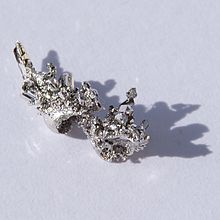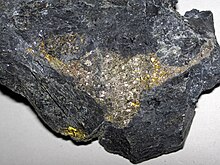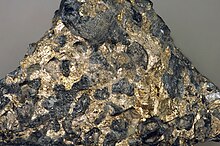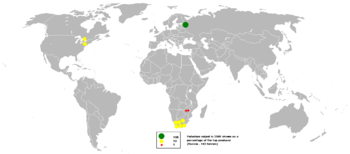
A | B | C | D | E | F | G | H | CH | I | J | K | L | M | N | O | P | Q | R | S | T | U | V | W | X | Y | Z | 0 | 1 | 2 | 3 | 4 | 5 | 6 | 7 | 8 | 9
 | ||||||||||||||||||||||||||||||||||||||||||||||||||||||||||
| Palladium | ||||||||||||||||||||||||||||||||||||||||||||||||||||||||||
|---|---|---|---|---|---|---|---|---|---|---|---|---|---|---|---|---|---|---|---|---|---|---|---|---|---|---|---|---|---|---|---|---|---|---|---|---|---|---|---|---|---|---|---|---|---|---|---|---|---|---|---|---|---|---|---|---|---|---|
| Pronunciation | /pəˈleɪdiəm/ | |||||||||||||||||||||||||||||||||||||||||||||||||||||||||
| Appearance | silvery white | |||||||||||||||||||||||||||||||||||||||||||||||||||||||||
| Standard atomic weight Ar°(Pd) | ||||||||||||||||||||||||||||||||||||||||||||||||||||||||||
| Palladium in the periodic table | ||||||||||||||||||||||||||||||||||||||||||||||||||||||||||
| ||||||||||||||||||||||||||||||||||||||||||||||||||||||||||
| Atomic number (Z) | 46 | |||||||||||||||||||||||||||||||||||||||||||||||||||||||||
| Group | group 10 | |||||||||||||||||||||||||||||||||||||||||||||||||||||||||
| Period | period 5 | |||||||||||||||||||||||||||||||||||||||||||||||||||||||||
| Block | d-block | |||||||||||||||||||||||||||||||||||||||||||||||||||||||||
| Electron configuration | [Kr] 4d10 | |||||||||||||||||||||||||||||||||||||||||||||||||||||||||
| Electrons per shell | 2, 8, 18, 18 | |||||||||||||||||||||||||||||||||||||||||||||||||||||||||
| Physical properties | ||||||||||||||||||||||||||||||||||||||||||||||||||||||||||
| Phase at STP | solid | |||||||||||||||||||||||||||||||||||||||||||||||||||||||||
| Melting point | 1828.05 K (1554.9 °C, 2830.82 °F) | |||||||||||||||||||||||||||||||||||||||||||||||||||||||||
| Boiling point | 3236 K (2963 °C, 5365 °F) | |||||||||||||||||||||||||||||||||||||||||||||||||||||||||
| Density (at 20° C) | 12.007 g/cm3[3] | |||||||||||||||||||||||||||||||||||||||||||||||||||||||||
| when liquid (at m.p.) | 10.38 g/cm3 | |||||||||||||||||||||||||||||||||||||||||||||||||||||||||
| Heat of fusion | 16.74 kJ/mol | |||||||||||||||||||||||||||||||||||||||||||||||||||||||||
| Heat of vaporization | 358 kJ/mol | |||||||||||||||||||||||||||||||||||||||||||||||||||||||||
| Molar heat capacity | 25.98 J/(mol·K) | |||||||||||||||||||||||||||||||||||||||||||||||||||||||||
Vapor pressure
| ||||||||||||||||||||||||||||||||||||||||||||||||||||||||||
| Atomic properties | ||||||||||||||||||||||||||||||||||||||||||||||||||||||||||
| Oxidation states | 0, +1, +2, +3, +4, +5[4] (a mildly basic oxide) | |||||||||||||||||||||||||||||||||||||||||||||||||||||||||
| Electronegativity | Pauling scale: 2.20 | |||||||||||||||||||||||||||||||||||||||||||||||||||||||||
| Ionization energies |
| |||||||||||||||||||||||||||||||||||||||||||||||||||||||||
| Atomic radius | empirical: 137 pm | |||||||||||||||||||||||||||||||||||||||||||||||||||||||||
| Covalent radius | 139±6 pm | |||||||||||||||||||||||||||||||||||||||||||||||||||||||||
| Van der Waals radius | 163 pm | |||||||||||||||||||||||||||||||||||||||||||||||||||||||||
| Other properties | ||||||||||||||||||||||||||||||||||||||||||||||||||||||||||
| Natural occurrence | primordial | |||||||||||||||||||||||||||||||||||||||||||||||||||||||||
| Crystal structure | face-centered cubic (fcc) (cF4) | |||||||||||||||||||||||||||||||||||||||||||||||||||||||||
| Lattice constant | a = 389.02 pm (at 20 °C)[3] | |||||||||||||||||||||||||||||||||||||||||||||||||||||||||
| Thermal expansion | 11.77×10−6/K (at 20 °C)[3] | |||||||||||||||||||||||||||||||||||||||||||||||||||||||||
| Thermal conductivity | 71.8 W/(m⋅K) | |||||||||||||||||||||||||||||||||||||||||||||||||||||||||
| Electrical resistivity | 105.4 nΩ⋅m (at 20 °C) | |||||||||||||||||||||||||||||||||||||||||||||||||||||||||
| Magnetic ordering | paramagnetic[5] | |||||||||||||||||||||||||||||||||||||||||||||||||||||||||
| Molar magnetic susceptibility | +567.4×10−6 cm3/mol (288 K)[6] | |||||||||||||||||||||||||||||||||||||||||||||||||||||||||
| Young's modulus | 121 GPa | |||||||||||||||||||||||||||||||||||||||||||||||||||||||||
| Shear modulus | 44 GPa | |||||||||||||||||||||||||||||||||||||||||||||||||||||||||
| Bulk modulus | 180 GPa | |||||||||||||||||||||||||||||||||||||||||||||||||||||||||
| Speed of sound thin rod | 3070 m/s (at 20 °C) | |||||||||||||||||||||||||||||||||||||||||||||||||||||||||
| Poisson ratio | 0.39 | |||||||||||||||||||||||||||||||||||||||||||||||||||||||||
| Mohs hardness | 4.75 | |||||||||||||||||||||||||||||||||||||||||||||||||||||||||
| Vickers hardness | 400–600 MPa | |||||||||||||||||||||||||||||||||||||||||||||||||||||||||
| Brinell hardness | 320–610 MPa | |||||||||||||||||||||||||||||||||||||||||||||||||||||||||
| CAS Number | 7440-05-3 | |||||||||||||||||||||||||||||||||||||||||||||||||||||||||
| History | ||||||||||||||||||||||||||||||||||||||||||||||||||||||||||
| Naming | after asteroid Pallas, itself named after Pallas Athena | |||||||||||||||||||||||||||||||||||||||||||||||||||||||||
| Discovery and first isolation | William Hyde Wollaston (1802) | |||||||||||||||||||||||||||||||||||||||||||||||||||||||||
| Isotopes of palladium | ||||||||||||||||||||||||||||||||||||||||||||||||||||||||||
| ||||||||||||||||||||||||||||||||||||||||||||||||||||||||||
Palladium is a chemical element; it has symbol Pd and atomic number 46. It is a rare and lustrous silvery-white metal discovered in 1802 by the English chemist William Hyde Wollaston. He named it after the asteroid Pallas, which was itself named after the epithet of the Greek goddess Athena, acquired by her when she slew Pallas. Palladium, platinum, rhodium, ruthenium, iridium and osmium form a group of elements referred to as the platinum group metals (PGMs). They have similar chemical properties, but palladium has the lowest melting point and is the least dense of them.
More than half the supply of palladium and its congener platinum is used in catalytic converters, which convert as much as 90% of the harmful gases in automobile exhaust (hydrocarbons, carbon monoxide, and nitrogen dioxide) into nontoxic substances (nitrogen, carbon dioxide and water vapor). Palladium is also used in electronics, dentistry, medicine, hydrogen purification, chemical applications, groundwater treatment, and jewelry. Palladium is a key component of fuel cells, in which hydrogen and oxygen react to produce electricity, heat, and water.
Ore deposits of palladium and other PGMs are rare. The most extensive deposits have been found in the norite belt of the Bushveld Igneous Complex covering the Transvaal Basin in South Africa; the Stillwater Complex in Montana, United States; the Sudbury Basin and Thunder Bay District of Ontario, Canada; and the Norilsk Complex in Russia. Recycling is also a source, mostly from scrapped catalytic converters. The numerous applications and limited supply sources result in considerable investment interest.
Characteristics
Palladium belongs to group 10 in the periodic table, but the configuration in the outermost electrons is in accordance with Hund's rule. Electrons that by the Madelung rule would be expected to occupy the 5s instead fill the 4d orbitals, as it is more energetically favorable to have a completely filled 4d10 shell instead of the 5s2 4d8 configuration.[clarification needed]
| Z | Element | No. of electrons/shell |
|---|---|---|
| 28 | nickel | 2, 8, 16, 2 (or 2, 8, 17, 1) |
| 46 | palladium | 2, 8, 18, 18, 0 |
| 78 | platinum | 2, 8, 18, 32, 17, 1 |
| 110 | darmstadtium | 2, 8, 18, 32, 32, 16, 2 (predicted) |
This 5s0 configuration, unique in period 5, makes palladium the heaviest element having only one incomplete electron shell, with all shells above it empty.
Palladium has the appearance of a soft silver-white metal that resembles platinum. It is the least dense and has the lowest melting point of the platinum group metals. It is soft and ductile when annealed and is greatly increased in strength and hardness when cold-worked. Palladium dissolves slowly in concentrated nitric acid, in hot, concentrated sulfuric acid, and when finely ground, in hydrochloric acid.[8] It dissolves readily at room temperature in aqua regia.
Palladium does not react with oxygen at standard temperature (and thus does not tarnish in air). Palladium heated to 800 °C will produce a layer of palladium(II) oxide (PdO). It may slowly develop a slight brownish coloration over time, likely due to the formation of a surface layer of its monoxide.
Palladium films with defects produced by alpha particle bombardment at low temperature exhibit superconductivity having Tc = 3.2 K.[9]
Isotopes
Naturally occurring palladium is composed of seven isotopes, six of which are stable. The most stable radioisotopes are 107Pd with a half-life of 6.5 million years (found in nature), 103Pd with 17 days, and 100Pd with 3.63 days. Eighteen other radioisotopes have been characterized with atomic weights ranging from 90.94948(64) u (91Pd) to 122.93426(64) u (123Pd).[10] These have half-lives of less than thirty minutes, except 101Pd (half-life: 8.47 hours), 109Pd (half-life: 13.7 hours), and 112Pd (half-life: 21 hours).[11]
For isotopes with atomic mass unit values less than that of the most abundant stable isotope, 106Pd, the primary decay mode is electron capture with the primary decay product being rhodium. The primary mode of decay for those isotopes of Pd with atomic mass greater than 106 is beta decay with the primary product of this decay being silver.[11]
Radiogenic 107Ag is a decay product of 107Pd and was first discovered in 1978[12] in the Santa Clara[13] meteorite of 1976. The discoverers suggest that the coalescence and differentiation of iron-cored small planets may have occurred 10 million years after a nucleosynthetic event. 107Pd versus Ag correlations observed in bodies, which have been melted since accretion of the Solar System, must reflect the presence of short-lived nuclides in the early Solar System.[14] 107
Pd is also produced as a fission product in spontaneous or induced fission of 235
U. As it is not very mobile in the environment and has a relatively low decay energy, 107
Pd is usually considered to be among the less concerning of the long-lived fission products.
Compounds
Palladium compounds exist primarily in the 0 and +2 oxidation state. Other less common states are also recognized. Generally the compounds of palladium are more similar to those of platinum than those of any other element.
-
Structure of α-PdCl2
-
Structure of β-PdCl2
Palladium(II)
Palladium(II) chloride is the principal starting material for other palladium compounds. It arises by the reaction of palladium with chlorine. It is used to prepare heterogeneous palladium catalysts such as palladium on barium sulfate, palladium on carbon, and palladium chloride on carbon.[15] Solutions of PdCl2 in nitric acid react with acetic acid to give palladium(II) acetate, also a versatile reagent. PdCl2 reacts with ligands (L) to give square planar complexes of the type PdCl2L2. One example of such complexes is the benzonitrile derivative PdCl2(PhCN)2.[16][17]
The complex bis(triphenylphosphine)palladium(II) dichloride is a useful catalyst.[18]



Palladium(0)
Palladium forms a range of zerovalent complexes with the formula PdL4, PdL3 and PdL2. For example, reduction of a mixture of PdCl2(PPh3)2 and PPh3 gives tetrakis(triphenylphosphine)palladium(0):[19]
- 2 PdCl2(PPh3)2 + 4 PPh3 + 5 N2H4 → 2 Pd(PPh3)4 + N2 + 4 N2H5+Cl−
Another major palladium(0) complex, tris(dibenzylideneacetone)dipalladium(0) (Pd2(dba)3), is prepared by reducing sodium tetrachloropalladate in the presence of dibenzylideneacetone.[20]
Palladium(0), as well as palladium(II), are catalysts in coupling reactions, as has been recognized by the 2010 Nobel Prize in Chemistry to Richard F. Heck, Ei-ichi Negishi, and Akira Suzuki. Such reactions are widely practiced for the synthesis of fine chemicals. Prominent coupling reactions include the Heck, Suzuki, Sonogashira coupling, Stille reactions, and the Kumada coupling. Palladium(II) acetate, tetrakis(triphenylphosphine)palladium(0) (Pd(PPh3)4), and tris(dibenzylideneacetone)dipalladium(0) (Pd2(dba)3) serve either as catalysts or precatalysts.[21]
Other oxidation states
Although Pd(IV) compounds are comparatively rare, one example is sodium hexachloropalladate(IV), Na2. A few compounds of palladium(III) are also known.[22] Palladium(VI) was claimed in 2002,[23][24] but subsequently disproven.[25][26]
Mixed valence palladium complexes exist, e.g. Pd4(CO)4(OAc)4Pd(acac)2 forms an infinite Pd chain structure, with alternatively interconnected Pd4(CO)4(OAc)4 and Pd(acac)2 units.[27]
When alloyed with a more electropositive element, palladium can acquire a negative charge. Such compounds are known as palladides, such as gallium palladide.[28] Palladides with the stoichiometry RPd3 exist where R is scandium, yttrium, or any of the lanthanides.[29]
Occurrence

As overall mine production of palladium reached 210,000 kilograms in 2022, Russia was the top producer with 88,000 kilograms, followed by South Africa, Canada, the U.S., and Zimbabwe.[30] Russia's company Norilsk Nickel ranks first among the largest palladium producers globally, accounting for 39% of the world's production.[31]
Palladium can be found as a free metal alloyed with gold and other platinum-group metals in placer deposits of the Ural Mountains, Australia, Ethiopia, North and South America. For the production of palladium, these deposits play only a minor role. The most important commercial sources are nickel-copper deposits found in the Sudbury Basin, Ontario, and the Norilsk–Talnakh deposits in Siberia. The other large deposit is the Merensky Reef platinum group metals deposit within the Bushveld Igneous Complex South Africa. The Stillwater igneous complex of Montana and the Roby zone ore body of the Lac des Îles igneous complex of Ontario are the two other sources of palladium in Canada and the United States.[32][33] Palladium is found in the rare minerals cooperite[34] and polarite.[35] Many more Pd minerals are known, but all of them are very rare.[36]
Palladium is also produced in nuclear fission reactors and can be extracted from spent nuclear fuel (see synthesis of precious metals), though this source for palladium is not used. None of the existing nuclear reprocessing facilities are equipped to extract palladium from the high-level radioactive waste.[37] A complication for the recovery of palladium in spent fuel is the presence of 107
Pd, a slightly radioactive long-lived fission product. Depending on end use, the radioactivity contributed by the 107
Pd might make the recovered palladium unusable without a costly step of isotope separation.
Applications


The largest use of palladium today is in catalytic converters.[38] Palladium is also used in jewelry, dentistry,[38][39] watch making, blood sugar test strips, aircraft spark plugs, surgical instruments, and electrical contacts.[40] Palladium is also used to make some professional transverse (concert or classical) flutes.[41] As a commodity, palladium bullion has ISO currency codes of XPD and 964. Palladium is one of only four metals to have such codes, the others being gold, silver and platinum.[42] Because it adsorbs hydrogen, palladium was a key component of the controversial cold fusion experiments of the late 1980s.[43]
Catalysis
When it is finely divided, as with palladium on carbon, palladium forms a versatile catalyst; it speeds heterogeneous catalytic processes like hydrogenation, dehydrogenation, and petroleum cracking. Palladium is also essential to the Lindlar catalyst, also called Lindlar's Palladium.[44] A large number of carbon–carbon bonding reactions in organic chemistry are facilitated by palladium compound catalysts. For example:
- Heck reaction
- Suzuki coupling
- Tsuji-Trost reactions
- Wacker process
- Negishi reaction
- Stille coupling
- Sonogashira coupling
When dispersed on conductive materials, palladium is an excellent electrocatalyst for oxidation of primary alcohols in alkaline media.[45] Palladium is also a versatile metal for homogeneous catalysis, used in combination with a broad variety of ligands for highly selective chemical transformations.
Zdroj:https://en.wikipedia.org?pojem=Palladium_processing
Text je dostupný za podmienok Creative Commons Attribution/Share-Alike License 3.0 Unported; prípadne za ďalších podmienok. Podrobnejšie informácie nájdete na stránke Podmienky použitia.
Antropológia
Aplikované vedy
Bibliometria
Dejiny vedy
Encyklopédie
Filozofia vedy
Forenzné vedy
Humanitné vedy
Knižničná veda
Kryogenika
Kryptológia
Kulturológia
Literárna veda
Medzidisciplinárne oblasti
Metódy kvantitatívnej analýzy
Metavedy
Metodika
Text je dostupný za podmienok Creative
Commons Attribution/Share-Alike License 3.0 Unported; prípadne za ďalších
podmienok.
Podrobnejšie informácie nájdete na stránke Podmienky
použitia.
www.astronomia.sk | www.biologia.sk | www.botanika.sk | www.dejiny.sk | www.economy.sk | www.elektrotechnika.sk | www.estetika.sk | www.farmakologia.sk | www.filozofia.sk | Fyzika | www.futurologia.sk | www.genetika.sk | www.chemia.sk | www.lingvistika.sk | www.politologia.sk | www.psychologia.sk | www.sexuologia.sk | www.sociologia.sk | www.veda.sk I www.zoologia.sk




